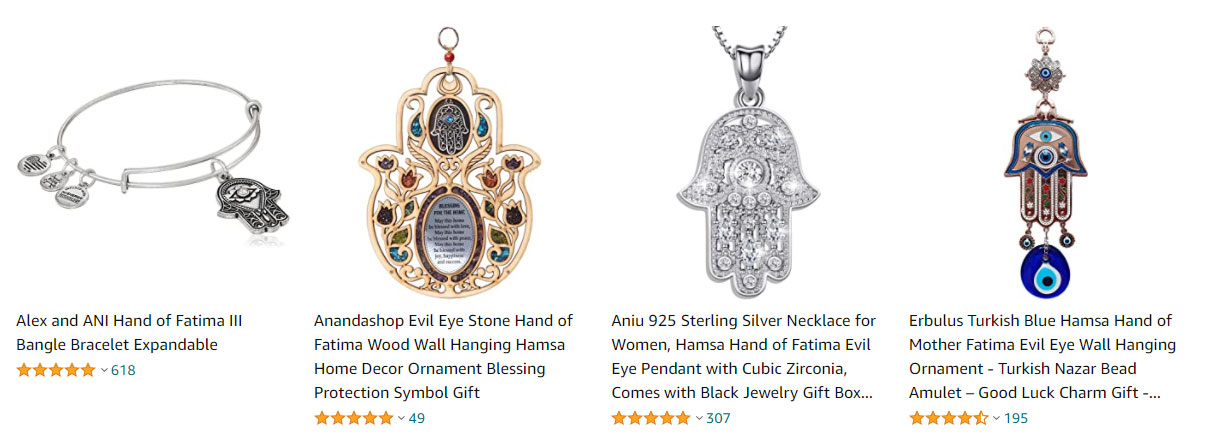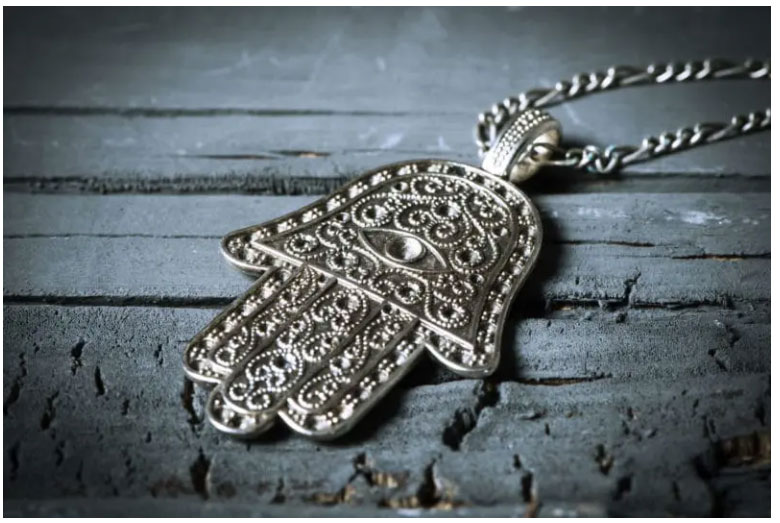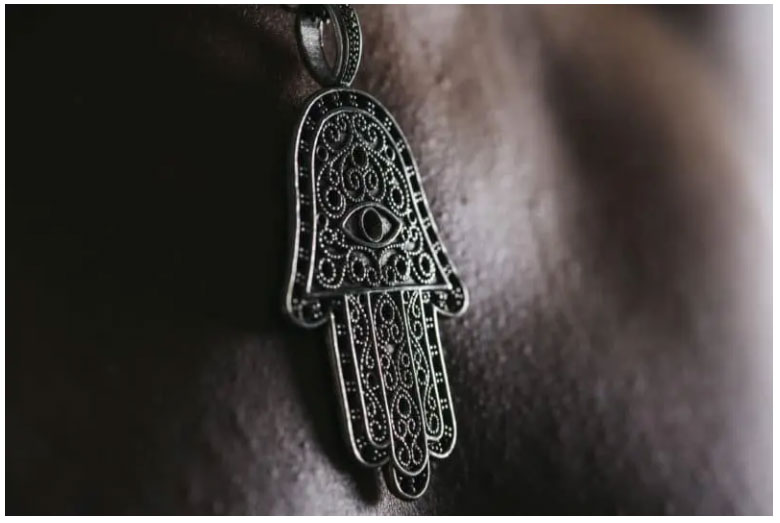Hand of fatima meaning
But what is the hand of fatima? It represents the shape of a rather peculiar hand. On the palm of the hand is an eye. It is considered a benevolent symbol. This representation, which has traveled the world for all the centuries, is certainly one of the most famous in the world. Here is everything you need to know about the Hand of Fatma.
What does the hand of Fatima represent?
Hand of Fatima, hand of Mary, hand of Miriam, hand of Hamsa, Tafust or Khmissa, the hand of Fatma is revealed with many names, but its representation remains the same. Indeed, it represents a human hand whose thumb and little finger are slightly apart while the other fingers stick together. In the middle of the hand, there is an eye in the middle which has the meaning of a protective and benevolent eye.
Fatma's hand has many representations and many meanings. Each culture and religion has its own meaning of the hand of Fatma. It is used in many representations of life and is most often served as an amulet or talisman, as jewelry, or as a decorative object.

The shape of Fatma's hand
The shape of Fatma's hand has evolved with time and beliefs. Thus, there are many variations in the world, but the basic characters are universally present. It can take the form of :
• A hand with 5 fingers pointing up and down
• Fingers glued together and not splayed out
• An eye in the heart of the palm of the hand.
The basic shape of Fatma's hand, found in the most common drawings, represents a hand with a symmetrical and identical thumb and little finger.
Some cultures, with the aim of appropriating it, do not hesitate to decorate the Fatma hand with drawings and shapes in order to make the symbol more aesthetic, more artistic or less common. Other civilizations do not hesitate to add color. The Arabs, for example, inscribe Arabic calligraphy on the amulet.
The color of Fatma's hand
The color of the Fatma hand is blue. This is the traditional color, but other beliefs have added colors and designs to the symbol. The color blue means two natural elements which are the sky and the sea. The color blue also means serenity, truth and wisdom.
The meaning of the hand
The 5 fingers of Fatma's hand represent the shape of the human hand. The thumb and the little finger seem to have the same size. But by the way, Fatma's hand seems to represent 2 inches on one and the same hand. But this is due to the fact that they were two palms of hands that are superimposed on each other. This superimposition means love and sharing.
In religions the 5 fingers can represent the 5 pillars of Islam, the 5 chakra energies or the 5 senses.
The meaning of the eye
Fatma's hand is characterized by an eye at the heart of the palm. Contrary to popular belief that this eye means "to see everything", to be able to observe or spy, the eye in the center of the hand is a protective eye. It is an eye that represents a guide, whether spiritual or physical. It allows, among other things, to ward off bad luck.

Origin of the hand of Hamsa
Since every religion and culture has its own history, the one that goes back to the oldest use of the hand of Fatma is the history of Phoenicia. Phoenicia is a Jewish civilization that settled in the Mediterranean region of North Africa.
Around 1500 BC, Phoenicians would have used the hand of Fatma to protect themselves from the evil eye. They considered them as a symbol of their venerated goddess Tanit, who watched over the capital of Phoenicia, Carthage. The hand, also called Tafust, watched over the Phoenicians and protected them from evil. Since then, it has been associated with all Berber beliefs and customs.
Fatma's hand and religions
Universal beliefs symbolize the hand of Fatma as a protective, caring eye. This is common to all monotheistic religions. Jews, Christians and Muslims use the hand of Fatma as a symbol of universal protection. When the belief spread in the East, established religions such as Hinduism, Buddhism also appropriated the hand of Fatma. All religions consider her as a supreme being who has the power to protect from good and evil.
Miriam's Hand and the Jewish Religion
The people of Phoenicia were essentially Jewish. The hand of Fatma meant Hamesh in Hebrew. It evokes two meanings. The first refers to the first five books of the Torah (holy book of the Jews). The second is derived from the teaching of Jewish precepts which use all five senses to worship God. That is why Hamsa's hand formed five fingers.
But among the Jews, the hand of Fatma is also called the hand of Miriam or the hand of Mary. Always in reference to the goddess Tanit who protected the people, it referred to two female characters, who are also divine protectors.
The first reference is that of the sister of the Jewish prophet Moses who was called Miriam. She is a protective female figure. According to the Torah, Miriam was an extraordinary woman since she did not receive the "curse of Eve".
The second reference is that of Mary, the mother of Jesus. Among the Jews, the hand of Mary is a protective hand, nourishing and also protects against the evil eye.
The hand of Mary and the Christian religion
Christianity doesn't really give much importance to Fatma's hand. But in the Christian religion, the hand of Fatma is considered the hand of Mary, mother of Jesus. According to Jewish precepts, the hand of Mary is also considered a protective hand among Christians. Indeed, the five books of Torah essentially form the Old Testament in the Bible.
Thus, Mary's special position and the Immaculate Conception made her stand out from all women around the world. She is considered the mother of all humanity. In the Christian context, Mary's hand represents God's divinity and power, as well as his power to exercise his will, giving men the gifts, talents and abilities necessary to achieve extraordinary things.
Mary's hand is used to remind Christians that they possess a divinity whose power enables them to overcome life's trials.
The hand of Fatma and the Islamic religion
When the hand of Hamsa spread to North Africa and the Middle East, the Islamic religion also appropriated this protective hand. However, the Islamic religion, which does not venerate the human body, refuses the use of an intermediary to ask for protection from Allah. The hand of Fatma therefore has no confessional meaning among Muslims and its use remains in the personal sphere.
According to legend, the hand of Fatima referred to a female figure: Fatima Zahra, who was the daughter of the Islamic Prophet Muhammad. The story goes that in the house of Mohammed, the Prophet, his daughter Fatima and her husband and children joined together under the same sheet. Muhammad then raised his right hand and prayed. An archangel appeared and affirmed that God wanted to free this family from defilement and thus purify it. The Archangel Jibriel then purified each member.
A little later, the hand of Fatima became the symbol of the five numbers that form the five pillars of Islam. It also referred to the first five figures of Islam that were pure and absolved of sin.
The hand of Fatma also represents protection against malicious creatures. Indeed, in another context, the hand of Fatima also protected Muslims against supernatural beings and magical creatures that influenced human life. In the Arab world, Muslims believed in creatures that could positively or negatively affect their lives. This story allowed the hand of Fatima to be the guardian of Muslims against the evil eye.

The hand of fatma and the Buddhist religion
In the Buddhist religion, the hand of Fatma represents the chakras. It is connected with the flow of energy that circulates in the body, but also with the five senses and the mudras. Thus, each finger is connected to its own chakra:
• The thumb: it represents the element of fire and is connected to the chakra of the solar plexus. • The index finger: it represents the air element and is connected to the heart chakra. • The middle finger: it represents the quintessence element or ether, it is connected to the throat chakra. • The ring finger: it represents the element of the earth and is connected to the root chakra. • Auricular: it represents the element of water and is connected to the sacred chakra.
When the chakras are combined, they change the flow of energy in the body. They also help to heal all psychological and physical ailments.
Fatma's hand and the tattoo
As a good luck charm, it is also possible to represent Fatma's hand as a tattoo on the body. Always bearing the same meaning, a tattoo of Fatma's hand is used to protect oneself in everyday life from bad luck. The symbol characterizes a universal protection that accompanies the body and allows to deliver the best energies in the body. The tattoo can be carried out on all parts of the body but generally it is placed on the arm, the back, the neck (to protect oneself from an opponent who comes from behind). It is also possible to tattoo the symbol on the wrist or ankle. The choice of location is often purely aesthetic. The tattoo is done with ink. It is also possible to add various patterns and colors according to your inspiration. To make it look a little more like art, some tattoo artists do not hesitate to add figures such as the Mandala for example.
Fatma's hand and the jewels
In modern culture, it is represented in jewelry or amulet. As a lucky charm, it can be worn as a necklace, bracelet or earrings.
Fatma hand necklaces are the most widespread. They are often associated with stones such as crystal or opal. Pendants are also very popular. They can be made of gold, silver, rhodium or alloy.
Rings or bracelets representing it are also popular. They are made of silver, alloy or modern materials.
The hand of Fatma as a decorative object
As an object of decoration, Fatma's hand is placed in strategic places in the house. For example, in the living room or in the main entrance of the house. It can also be placed in the bedroom, against bad dreams or bad spirits wandering around at night. Its role is to warn of dangers, to keep the inhabitants safe and to protect them from visitors with bad intentions. Fatma's hand, as a decorative object, is often made of silver, silver alloy, with ornaments. It is also possible to animate it with several colors, according to the inspiration of the manufacturer. Usually the color blue is used, but it is also possible to add other colors as well as other shapes.
Who can hold Fatma's hand?
In general, it is the women who wear it. As the hand of Fatma represents a feminine protection, it is mostly mothers, godmothers or nurses who carried it in ancient civilizations. The same remains true in modern times. No origin or history of the hand of Fatma evokes a certain prohibition, as for the wearing of this type of jewel by men. They can as well wear it.
Beyond its origins and beliefs, the hand of Fatma remains a universal protection. It protects you from the evil eye, envious and jealous. It is also used to solicit positive energies so do not hesitate to wear it with your favorite jewel.

